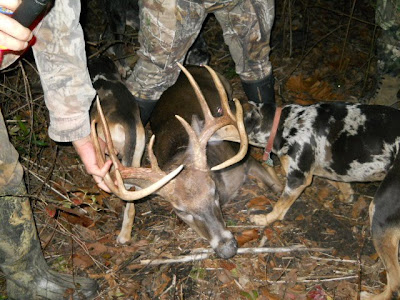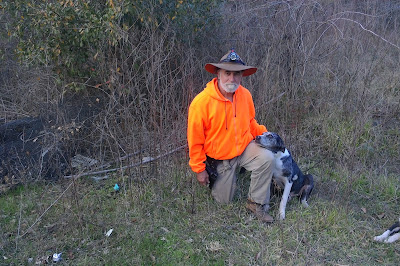It has been an interesting week, starting with Albert calling me about ‘problems’ he was having training a Blue Lacy to track. The Blue Lacy is a cur and is closely related to the Catahoula as breeds go. The Blue Lacy is the state dog of Texas, just like the Catahoula is the state dog of Louisiana.
The 2 photos below are compliments of Roy Hindes
The 2 photos above and below is Roy Hinds (in the black hat) with an awesome Blue Lacy
Here is a link to John's website about Roy and his Blue Lacy tracking dogs:
http://borntotracknews.blogspot.com/2009/01/roy-hindes-iii-his-tracking-dogs-and.html
The 2 photos below are compliments of Roy Hindes
The 2 photos above and below is Roy Hinds (in the black hat) with an awesome Blue Lacy
Here is a link to John's website about Roy and his Blue Lacy tracking dogs:
http://borntotracknews.blogspot.com/2009/01/roy-hindes-iii-his-tracking-dogs-and.html
Albert told me that his dog was starting to run or 'hunt‘ rabbits
when in training. I asked “What is the dog’s experience with tracking deer?”
And the man told me that he never tracked a wounded deer with the dog, but had only “trained”
it. I then asked how old and he told me
1 ½ years old. I advised him to start ‘working’ the dog on real natural ‘deer
made’ blood trails and stop ‘training’ the dog.
It is hunting season, he wants to hunt, so take
the dog hunting!
This one phone call got me to thinking about the emphasis
hunters, trainers and trackers put on training with man-made blood trails and I
began to see that training is everything in most people’s mind. Much like
someone wanting to buy a finished dog because in their mind experience is everything and many people shopping for a tracking dog and having no experience to base their purchase on and are guessing a finished dog is the best way to go.
.
.
Both presumptions are wrong!
When I started
studying the blood trail dog as a business, about 10 years ago, it was obvious that
too many people were over-complicating the training process by focusing on
tarsal gland or interdigital gland training. And the result of that has been several people calling me this year to get 'another' dog because their dog was trained specifically
to track bucks only using the tarsal and or interdigital gland method and now it will only track bucks. Duhhhh!
interdigital gland
The tarsal gland is a furry bump on the heels of the back legs of a buck as seen below
interdigital gland
I recall all the blood
trail dog propaganda years ago being presented by a local blood trail dog association about a dog knowing if a deer was mortally
wounded OR NOT by the smell of the interdigital gland which is located between
a deer’s toes. . Here is the theory: If a deer is mortally wounded, it gives
off a different scent through the interdigital gland, than one that is not mortally
wounded. And… an experienced and well trained dogs knows it.
And if a dog knows it is not mortally wounded, IT WON'T TRACK?
OK, how can you ‘prove’ that theory? Ask the dog? Of course we can’t get a verbal confirmation of that so we must base that judgement upon the dog’s body language and performance.
And if a dog knows it is not mortally wounded, IT WON'T TRACK?
OK, how can you ‘prove’ that theory? Ask the dog? Of course we can’t get a verbal confirmation of that so we must base that judgement upon the dog’s body language and performance.
So here is my observation: A professional tracker and his
dog was 0 for 4 at a local hunting club that was located near the tracker. Four
times in a row he was called in the first month of archery season here in
Louisiana to track a deer and the dog couldn’t find it. A member of the club later called me looking to buy a tracking dog for their hunting club because they
were not calling the ‘other’ tracker anymore due to a lack of performance.
In short, the professional tracker excused his dog for ‘not
tracking’ due to the dog knowing it was not a mortal wound due to the
interdigital gland 'theory'.
Well on two occasions of the four, the next day after the
tracker came out, the deer hunters went out to the blood trail at the crack of
dawn and looked for the deer and found it without a dog. One of the deer was about 60 yards
from where the dog stopped tracking, and the other was about 100 yards away from
the point of last blood. And on the latter, the dog wound not track at all. He just ran around and played with the hunters.
Now folks this is a dog that had found many a deer in his day and had been tracking for many years successfully. OK, well bred, well trained, and well experienced, so why wouldn’t the dog hunt?
.
Above is Rob Miller and his dachshund Sypris who has found several hundred recoveries in Michigan and Ohio.
If you need tracking services, Robert can be reached by cell phone @ 810 240 4891
Based upon my personal experience, my best guess is that the dog was over fed. Always remember the common sense wisdom of the old timers: “Hungry dogs hunt!” Also, consider that the tracker was a member of an association at the time that was hung up on the interdigital gland theory and was using that to make unwarranted excuses for the dog.
Now folks this is a dog that had found many a deer in his day and had been tracking for many years successfully. OK, well bred, well trained, and well experienced, so why wouldn’t the dog hunt?
.
Above is Rob Miller and his dachshund Sypris who has found several hundred recoveries in Michigan and Ohio.
If you need tracking services, Robert can be reached by cell phone @ 810 240 4891
Based upon my personal experience, my best guess is that the dog was over fed. Always remember the common sense wisdom of the old timers: “Hungry dogs hunt!” Also, consider that the tracker was a member of an association at the time that was hung up on the interdigital gland theory and was using that to make unwarranted excuses for the dog.
My guess is the dog was so over fed on a regular basis that
he perhaps wouldn’t hunt on a regular basis and it is not the dogs fault!
Proper handling while actually tracking may be more important than early
training because if the dog is a genetically predisposed 'natural', they may not need to be trained to the degree that most people believe.
And I believe the diet factors are more critical than the training and I feed my dogs raw beef when it is not deer season as you can see below.
I also like to supplement that with road kill as often as possible, as you can see below.
I am not opposed to using man made tracks to train puppies but the real blood trail dog training occurs during deer season unless you have does that need to be culled during the off season and have doe tags to that effect.
Starting in 2018, I will be moving into a 13,000 acre high fence trophy ranch and training my pups on culled does in the off season and eradicating the wild hog population on the ranch.
I am Marcus de la Houssaye and I breed and train Louisiana Catahoulas.
I can be reached at 337 298 2630 if you are interested in buying a puppy or started dog or have questions about training one.
And I believe the diet factors are more critical than the training and I feed my dogs raw beef when it is not deer season as you can see below.
I also like to supplement that with road kill as often as possible, as you can see below.
I am not opposed to using man made tracks to train puppies but the real blood trail dog training occurs during deer season unless you have does that need to be culled during the off season and have doe tags to that effect.
Starting in 2018, I will be moving into a 13,000 acre high fence trophy ranch and training my pups on culled does in the off season and eradicating the wild hog population on the ranch.
I am Marcus de la Houssaye and I breed and train Louisiana Catahoulas.
I can be reached at 337 298 2630 if you are interested in buying a puppy or started dog or have questions about training one.

















